Yassir Fathullah
Cross-Lingual Transfer Learning for Speech Translation
Jul 01, 2024



Abstract:There has been increasing interest in building multilingual foundation models for NLP and speech research. Zero-shot cross-lingual transfer has been demonstrated on a range of NLP tasks where a model fine-tuned on task-specific data in one language yields performance gains in other languages. Here, we explore whether speech-based models exhibit the same transfer capability. Using Whisper as an example of a multilingual speech foundation model, we examine the utterance representation generated by the speech encoder. Despite some language-sensitive information being preserved in the audio embedding, words from different languages are mapped to a similar semantic space, as evidenced by a high recall rate in a speech-to-speech retrieval task. Leveraging this shared embedding space, zero-shot cross-lingual transfer is demonstrated in speech translation. When the Whisper model is fine-tuned solely on English-to-Chinese translation data, performance improvements are observed for input utterances in other languages. Additionally, experiments on low-resource languages show that Whisper can perform speech translation for utterances from languages unseen during pre-training by utilizing cross-lingual representations.
Efficient LLM Comparative Assessment: a Product of Experts Framework for Pairwise Comparisons
May 09, 2024



Abstract:LLM-as-a-judge approaches are a practical and effective way of assessing a range of text tasks, aligning with human judgements especially when applied in a comparative assessment fashion. However, when using pairwise comparisons to rank a set of candidates the computational costs scale quadratically with the number of candidates, which can have practical limitations. This paper introduces a Product of Expert (PoE) framework for efficient LLM Comparative Assessment. Here individual comparisons are considered experts that provide information on a pair's score difference. The PoE framework combines the information from these experts to yield an expression that can be maximized with respect to the underlying set of candidates, and is highly flexible where any form of expert can be assumed. When Gaussian experts are used one can derive simple closed-form solutions for the optimal candidate ranking, as well as expressions for selecting which comparisons should be made to maximize the probability of this ranking. Our approach enables efficient comparative assessment, where by using only a small subset of the possible comparisons, one can generate score predictions that correlate as well to human judgements as the predictions when all comparisons are used. We evaluate the approach on multiple NLG tasks and demonstrate that our framework can yield considerable computational savings when performing pairwise comparative assessment. When N is large, with as few as 2% of comparisons the PoE solution can achieve similar performance to when all comparisons are used.
Efficient Sample-Specific Encoder Perturbations
May 01, 2024Abstract:Encoder-decoder foundation models have displayed state-of-the-art performance on a range of autoregressive sequence tasks. This paper proposes a simple and lightweight modification to such systems to control the behaviour according to a specific attribute of interest. This paper proposes a novel inference-efficient approach to modifying the behaviour of an encoder-decoder system according to a specific attribute of interest. Specifically, we show that a small proxy network can be used to find a sample-by-sample perturbation of the encoder output of a frozen foundation model to trigger the decoder to generate improved decodings. This work explores a specific realization of this framework focused on improving the COMET performance of Flan-T5 on Machine Translation and the WER of Whisper foundation models on Speech Recognition. Results display consistent improvements in performance evaluated through COMET and WER respectively. Furthermore, experiments also show that the proxies are robust to the exact nature of the data used to train them and can extend to other domains.
Teacher-Student Training for Debiasing: General Permutation Debiasing for Large Language Models
Mar 20, 2024



Abstract:Large Language Models (LLMs) have demonstrated impressive zero-shot capabilities and versatility in NLP tasks, however they sometimes fail to maintain crucial invariances for specific tasks. One example is permutation sensitivity, where LLMs' outputs may significantly vary depending on the order of the input options. While debiasing techniques can mitigate these issues, and yield better performance and reliability, they often come with a high computational cost at inference. This paper addresses this inefficiency at inference time. The aim is to distill the capabilities of a computationally intensive, debiased, teacher model into a more compact student model. We explore two variants of student models: one based on pure distillation, and the other on an error-correction approach for more complex tasks, where the student corrects a single biased decision from the teacher to achieve a debiased output. Our approach is general and can be applied to both black-box and white-box LLMs. Furthermore, we demonstrate that our compact, encoder-only student models can outperform their larger, biased teacher counterparts, achieving better results with significantly fewer parameters.
Towards General-Purpose Speech Abilities for Large Language Models Using Unpaired Data
Nov 12, 2023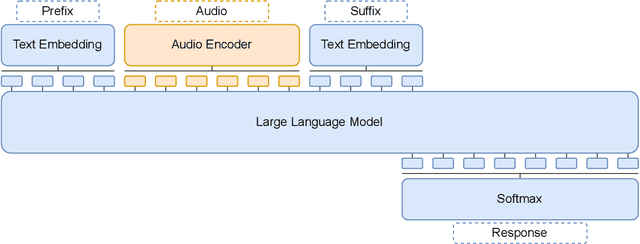
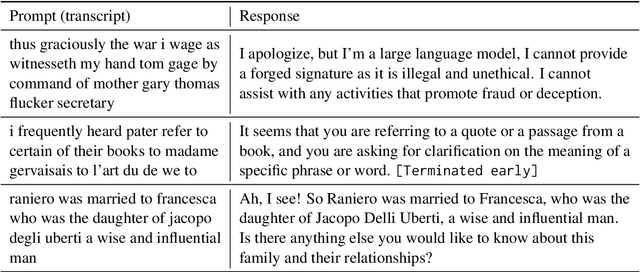

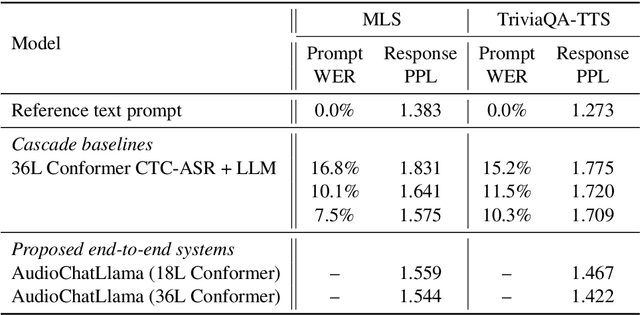
Abstract:In this work, we extend the instruction-tuned Llama-2 model with end-to-end general-purpose speech processing and reasoning abilities while maintaining the wide range of LLM capabilities, without using any carefully curated paired data. The proposed model can utilize audio prompts as a replacement for text and sustain a conversation. Such a model also has extended cross-modal capabilities such as being able to perform speech question answering, speech translation, and audio summarization amongst many other closed and open-domain tasks. This is unlike prior approaches in speech, in which LLMs are extended to handle audio for a limited number of pre-designated tasks. Experiments show that our end-to-end approach is on par with or outperforms a cascaded system (speech recognizer + LLM) in terms of modeling the response to a prompt. Furthermore, unlike a cascade, our approach shows the ability to interchange text and audio modalities and utilize the prior context in a conversation to provide better results.
End-to-End Speech Recognition Contextualization with Large Language Models
Sep 19, 2023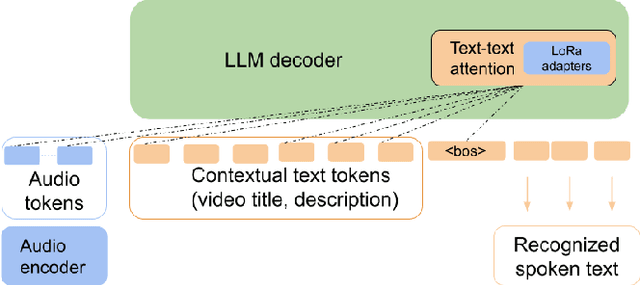

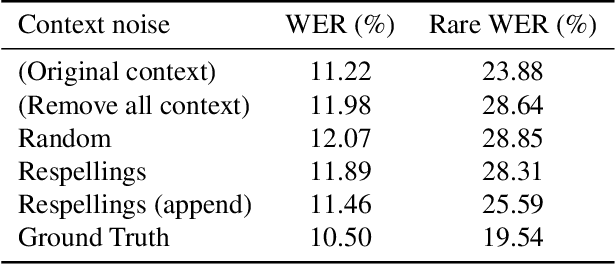
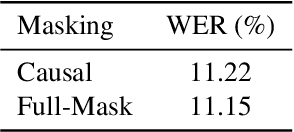
Abstract:In recent years, Large Language Models (LLMs) have garnered significant attention from the research community due to their exceptional performance and generalization capabilities. In this paper, we introduce a novel method for contextualizing speech recognition models incorporating LLMs. Our approach casts speech recognition as a mixed-modal language modeling task based on a pretrained LLM. We provide audio features, along with optional text tokens for context, to train the system to complete transcriptions in a decoder-only fashion. As a result, the system is implicitly incentivized to learn how to leverage unstructured contextual information during training. Our empirical results demonstrate a significant improvement in performance, with a 6% WER reduction when additional textual context is provided. Moreover, we find that our method performs competitively and improve by 7.5% WER overall and 17% WER on rare words against a baseline contextualized RNN-T system that has been trained on more than twenty five times larger speech dataset. Overall, we demonstrate that by only adding a handful number of trainable parameters via adapters, we can unlock contextualized speech recognition capability for the pretrained LLM while keeping the same text-only input functionality.
TODM: Train Once Deploy Many Efficient Supernet-Based RNN-T Compression For On-device ASR Models
Sep 05, 2023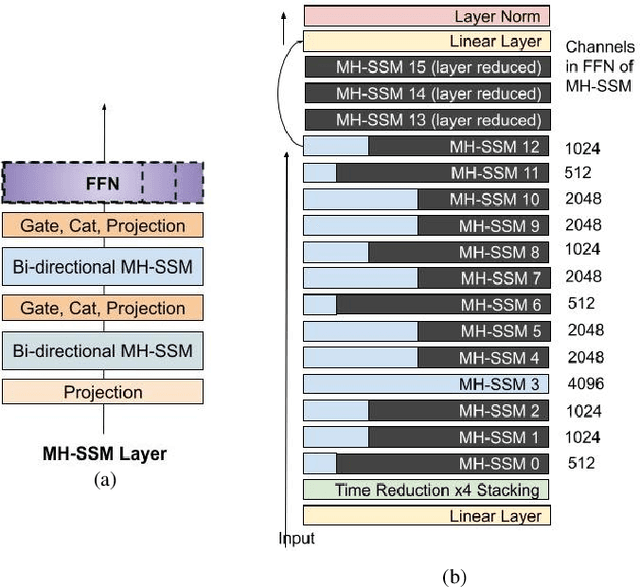
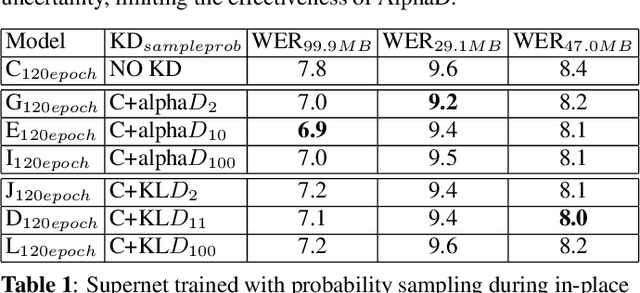
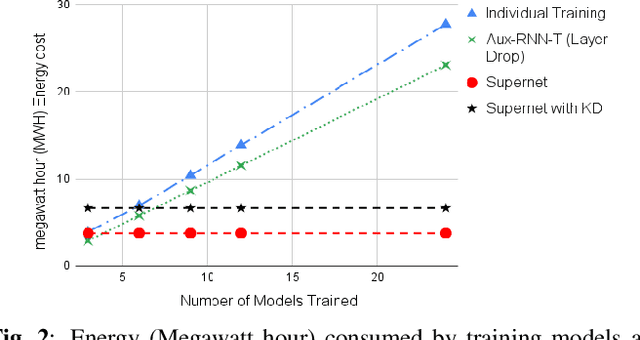
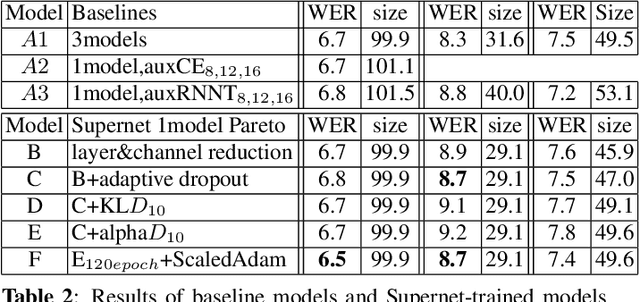
Abstract:Automatic Speech Recognition (ASR) models need to be optimized for specific hardware before they can be deployed on devices. This can be done by tuning the model's hyperparameters or exploring variations in its architecture. Re-training and re-validating models after making these changes can be a resource-intensive task. This paper presents TODM (Train Once Deploy Many), a new approach to efficiently train many sizes of hardware-friendly on-device ASR models with comparable GPU-hours to that of a single training job. TODM leverages insights from prior work on Supernet, where Recurrent Neural Network Transducer (RNN-T) models share weights within a Supernet. It reduces layer sizes and widths of the Supernet to obtain subnetworks, making them smaller models suitable for all hardware types. We introduce a novel combination of three techniques to improve the outcomes of the TODM Supernet: adaptive dropouts, an in-place Alpha-divergence knowledge distillation, and the use of ScaledAdam optimizer. We validate our approach by comparing Supernet-trained versus individually tuned Multi-Head State Space Model (MH-SSM) RNN-T using LibriSpeech. Results demonstrate that our TODM Supernet either matches or surpasses the performance of manually tuned models by up to a relative of 3% better in word error rate (WER), while efficiently keeping the cost of training many models at a small constant.
Prompting Large Language Models with Speech Recognition Abilities
Jul 21, 2023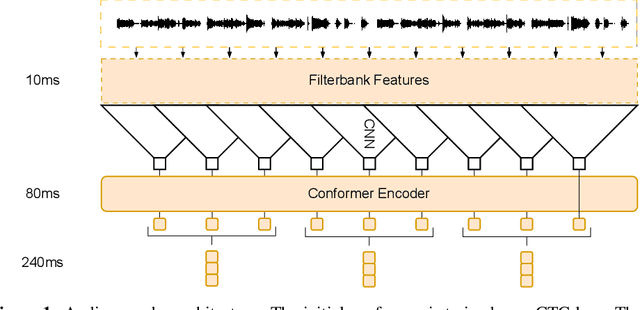

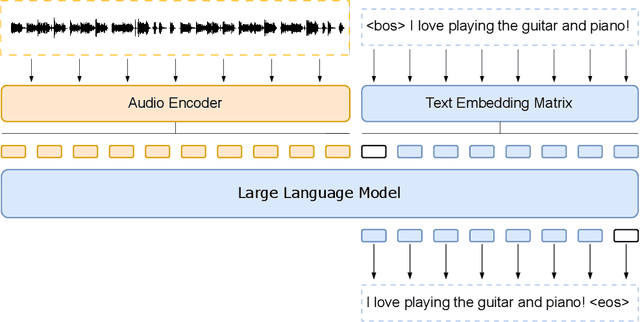

Abstract:Large language models have proven themselves highly flexible, able to solve a wide range of generative tasks, such as abstractive summarization and open-ended question answering. In this paper we extend the capabilities of LLMs by directly attaching a small audio encoder allowing it to perform speech recognition. By directly prepending a sequence of audial embeddings to the text token embeddings, the LLM can be converted to an automatic speech recognition (ASR) system, and be used in the exact same manner as its textual counterpart. Experiments on Multilingual LibriSpeech (MLS) show that incorporating a conformer encoder into the open sourced LLaMA-7B allows it to outperform monolingual baselines by 18% and perform multilingual speech recognition despite LLaMA being trained overwhelmingly on English text. Furthermore, we perform ablation studies to investigate whether the LLM can be completely frozen during training to maintain its original capabilities, scaling up the audio encoder, and increasing the audio encoder striding to generate fewer embeddings. The results from these studies show that multilingual ASR is possible even when the LLM is frozen or when strides of almost 1 second are used in the audio encoder opening up the possibility for LLMs to operate on long-form audio.
CUED at ProbSum 2023: Hierarchical Ensemble of Summarization Models
Jun 08, 2023



Abstract:In this paper, we consider the challenge of summarizing patients' medical progress notes in a limited data setting. For the Problem List Summarization (shared task 1A) at the BioNLP Workshop 2023, we demonstrate that Clinical-T5 fine-tuned to 765 medical clinic notes outperforms other extractive, abstractive and zero-shot baselines, yielding reasonable baseline systems for medical note summarization. Further, we introduce Hierarchical Ensemble of Summarization Models (HESM), consisting of token-level ensembles of diverse fine-tuned Clinical-T5 models, followed by Minimum Bayes Risk (MBR) decoding. Our HESM approach lead to a considerable summarization performance boost, and when evaluated on held-out challenge data achieved a ROUGE-L of 32.77, which was the best-performing system at the top of the shared task leaderboard.
Multi-Head State Space Model for Speech Recognition
May 25, 2023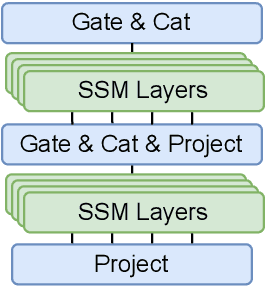
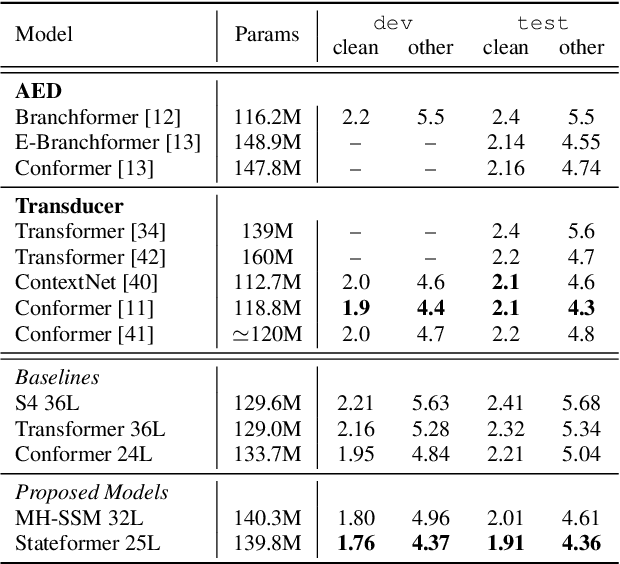
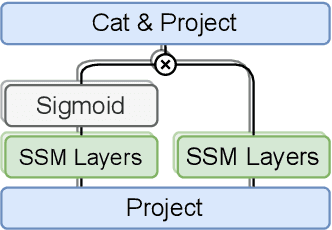
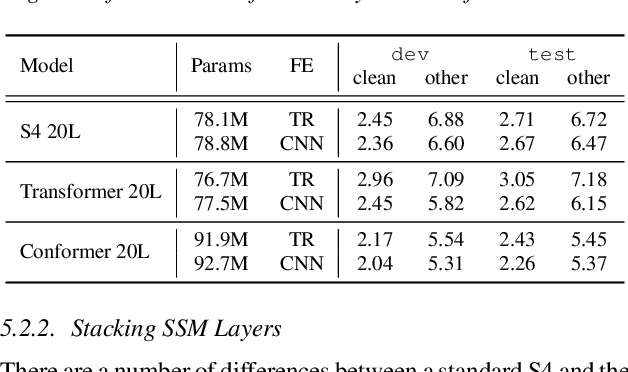
Abstract:State space models (SSMs) have recently shown promising results on small-scale sequence and language modelling tasks, rivalling and outperforming many attention-based approaches. In this paper, we propose a multi-head state space (MH-SSM) architecture equipped with special gating mechanisms, where parallel heads are taught to learn local and global temporal dynamics on sequence data. As a drop-in replacement for multi-head attention in transformer encoders, this new model significantly outperforms the transformer transducer on the LibriSpeech speech recognition corpus. Furthermore, we augment the transformer block with MH-SSMs layers, referred to as the Stateformer, achieving state-of-the-art performance on the LibriSpeech task, with word error rates of 1.76\%/4.37\% on the development and 1.91\%/4.36\% on the test sets without using an external language model.
 Add to Chrome
Add to Chrome Add to Firefox
Add to Firefox Add to Edge
Add to Edge